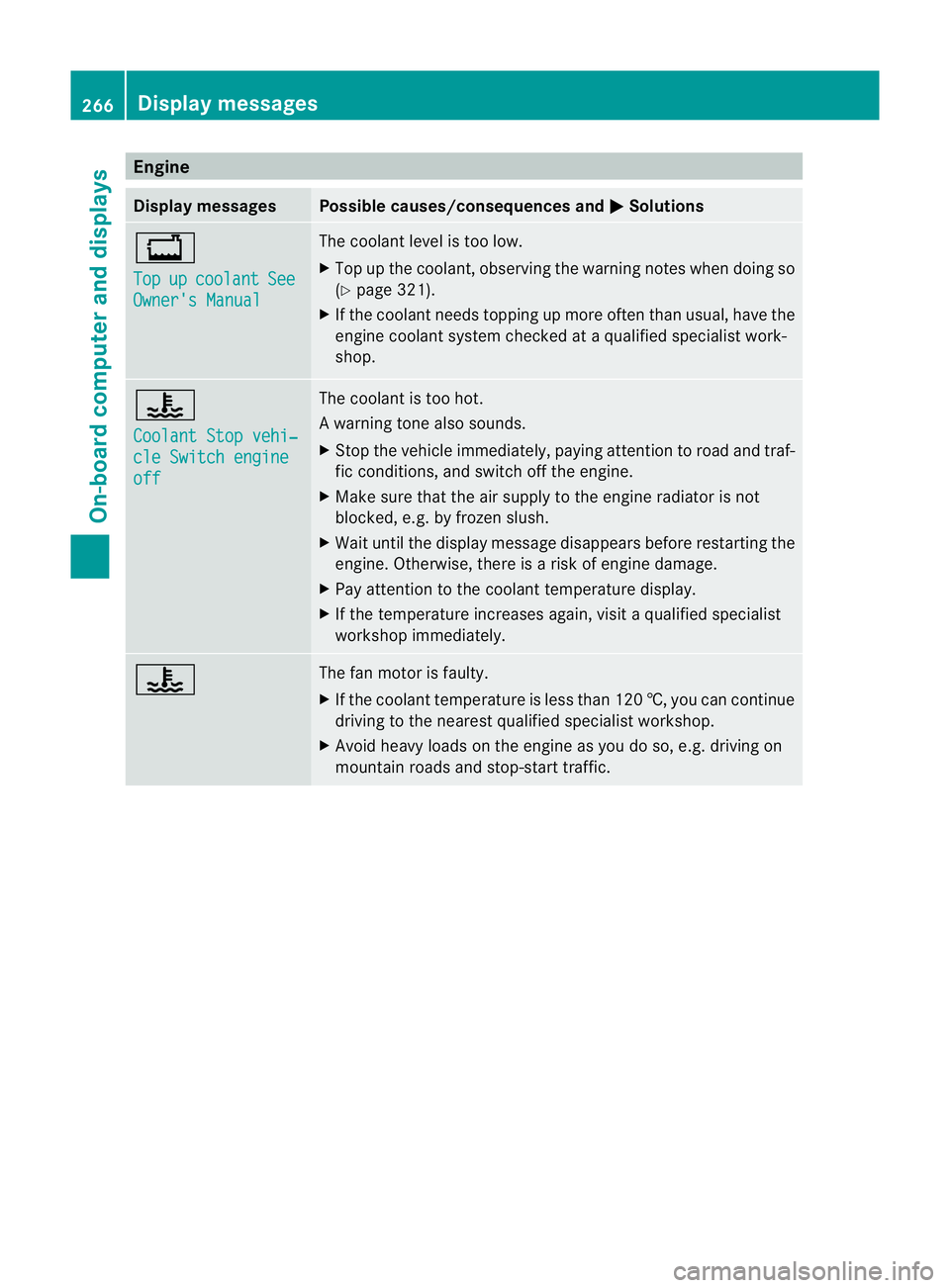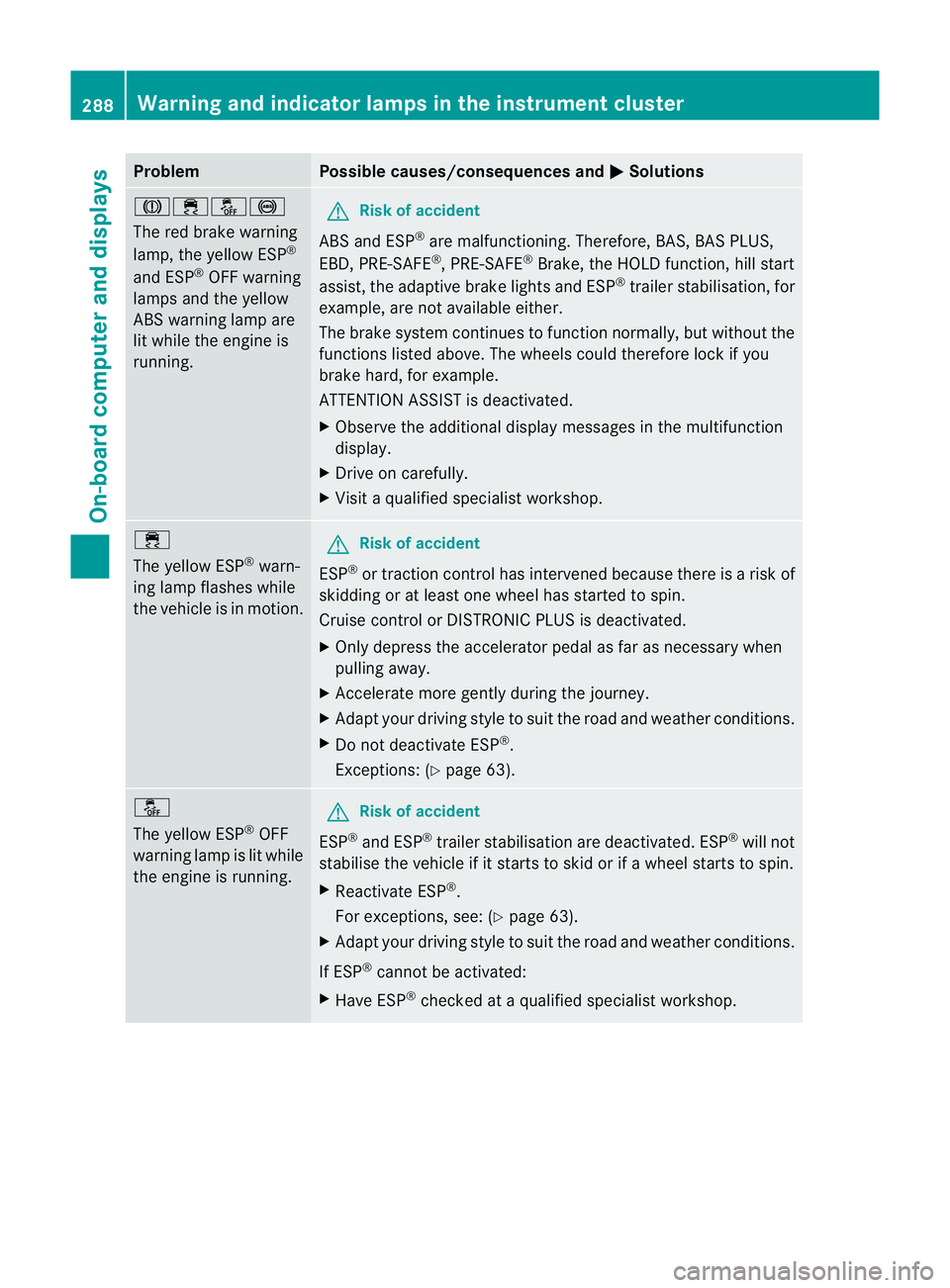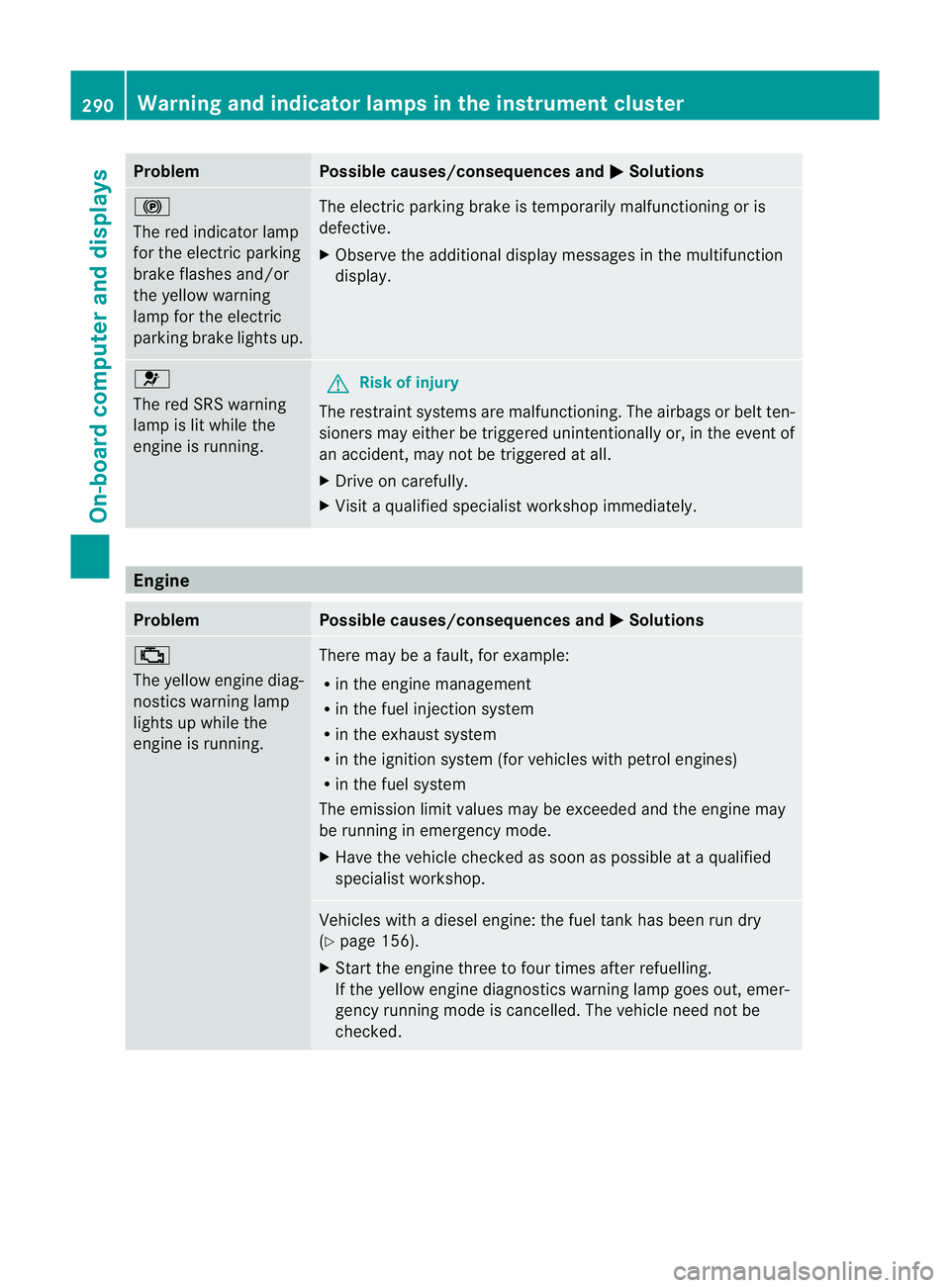2011 MERCEDES-BENZ M-CLASS SUV check engine
[x] Cancel search: check enginePage 213 of 389

the warning onl
yoccurs if the differenc ein
spee dislesst han 12 km/h.
The yellow indicator lamp goes out if reverse
gea rise ngaged. Blind Spot Assist is then
deactivated.
The brightness of the indicator/warning
lamps is adjusted automaticall yaccording to
the ambient light. G
WARNING
Blind Spot Assist is not active at speeds below
30 km/h, and the indicator lamps in the exte-
rior mirrors are yellow. Vehicles in the moni-
toring range are the nnot indicated.
Always pay attention to traffic condition sand
your surroundings .Otherwise, you may fail to
recognis edangers in time, cause an accident
and injure yoursel fand others.
Collisio nwarning
If av ehicle is detected in the mon itoring range
of Blind Spot Assis tand you switch on the turn
signal, adouble warnin gtone sounds. Red
warnin glamp :flashes .Ifthe tur nsignal
remains on, detected vehicles are indicated
by the flashing of red warnin glamp :.T here
ar enof urther warning tones.
Switching on Blind Spot Assist
X On vehicles without anavigation system,
make sure that the Becker ®
MAP PILOT is
connected; see the separate operating
instructions for Audio 20.
X Make sure that the radar senso rsystem
(Y page 249) and Blind Spot Assist
(Y page 245) are activated in the on-board
computer.
X Turn the key to position 2in the ignition
lock.
Warning lamps :ligh tupr ed in the exte-
rior mirror sfor approximately 1. 5seconds
and then tur nyellow.
Trailer towing
If you attach atrailer, make sure that yo uhave
correctly established the electrical connec-
tion. This can be accomplished by checking the trailer lighting
.Blind Spot Assist is then
deactivated. The indicator lamp in the exte-
rior mirrors lights up yellow, and the Blind Spot Assist currentl
yunavailable See Owner's Manual message appe
arsin
the multifunction display.
i You can deactivate the indicato rlamps in
the exterior mirrors.
To do so, switch off Blind Spot Assis tif:
R thek ey is in position 2in the ignition
lock.
R the engine is not running.
R the electrical connection to the trailer
has been established.
Lane Keeping Assist Important safety notes
Lan
eKeeping Assist monitor sthe area in
front of your vehicle by means of acamera at
the top of the windscreen. Lane Keeping
Assis tdetect slane markings on the road and
warns you before you leave your lane unin-
tentionally. :
Lane Keeping Assis tcamera
If you have chose nthe Displa yunit Speed-/odometer (Y
page 246) functio nin
the on-board computer and select km as the
unit of measurement, Active Lane Keeping
Assist is active from speeds of 60 km/h. If
the miles displa
yunit is selected ,the assis-
tance range begin sat40mph. 210
Driving systemsDriving and parking
Page 230 of 389

Do not exceed the maximum noseweight.
When driving with aloaded carriersystem,
always adjust your drivin gstyle to th eprevail-
ing road, traffic and weather conditions and
drive par ticularly carefully.
You can use carrier sys tems, e.g. bi cycle
racks or load-bea ringimplements on th eball
coupling. The maximum noseweight of 75 kg
applies when usin gcarrier system sontheball
coupling.
General information i
Chec kthe tyr epressure when towin ga
trailer. You will find the values in the tyre
pressure table in the fuel filler flap of the
vehicle (Y page 359).
You will find installation dimensions and loads
in the "Technical data" section
(Y page 378).
The maximum noseweight of the trailer draw-
bar on the ball coupling is 18
.H owever, the
actual noseweight must not exceed the value
given on the trailer tow hitc hortrailer identi-
ficatio nplates. The lowest weight applies.
! Use anoseweight as close as possible to
the maximum permissible noseweight .Do
not use anoseweight of less than 50 kg,
otherwise the trailer ma ycome loose.
Bear in min dthat the payload and the rear
axl eload ar ereduced by the actual nose-
weight.
Please note that when towing atrailer, PARK-
TRONIC (Y page 191) and Blind Spo tAssist
(Y page 208) ar eonly available with limita-
tions ,orn ot at all.
i On vehicles withou tlevel control, the
height of the ball couplin gwill alter accord-
ing to the load placed on the vehicle. If nec-
essary, use atrailer wit haheight-adjusta-
ble drawbar. Driving tips i
Observ ethe information on ESP ®
trailer
stabilisation (Y page 65)and on pull ing
away with atrailer. (Y page 141).
Vehicles wit hthe ON&OFFROAD package:
selec tthe trailer program (Y page 219) with
the off-road program selector wheel in the
cen treconsole.
Th em aximum permissible spee dfor vehicle/
trailer combination sdepends on the type of
trailer .Befor ebeginning the journey, check
the trailer's documents to see what the max-
imu mpermitted speed is. Observ ethe legally
prescribed maximum speed in the relevant
country.
For certai nMercedes-Ben zvehicles, the max-
imu mp ermissible rear axle load is inc reased
when towing atrailer. Refer to th e"Techni cal
data" section to fin dout whether this applies
to your vehicle. If you utilise any of the added
maximum rear axle load when towing atrailer,
th ev ehicle/trailer combination may not
exceed amaximum spee dof100 km/ hfor
reasons concer ning the operating permit.
Thi salso applies in countries in which the
permissible maximum speed for vehicle/
trailer combinations is above 100 km/h.
When towing atrailer, your vehicle's handling
characteristics will be differe ntin comparison
to when drivin gwithout atrailer and it will
consume more fuel.
On long and stee pdownhil lgradients ,you
must select shift range 1,2or 3in good time.
i This also applies if you have activated
cruise con trol, SPEEDTRONIC or DI S-
TRONIC PLUS.
This will use the brakin geffect of th eengine,
so les sbraking wil lberequired to maintain
the speed. This relieves the load on the brake
system and prevent sthe brakes from over-
heating and wearing too quickly .Ifyou need
additional braking, depress the brake pedal
repeatedly rather than con tinuously.
18 Data unavailable at time of going to print. Towing
atrailer
227Driving andparki ng Z
Page 269 of 389

Engine
Display messages Possible causes/consequences and
M Solutions
+
Top
up co
olant See
Owner'
sManual Th
ec oolant leve listoo low.
X Top up th ecoolant ,obser ving the warning note swhen doin gso
( Y page 321).
X If th ecoolant needs toppin gupmoreo ften than usual ,have the
engin ecoolant system checked at aqualified specialist work-
shop. ?
Co
olantS topv ehi‐ cle Switch engine
off Th
ec oolant is to ohot.
Aw arning ton ealso sounds.
X Stop th evehicle immediately, payin gattentio ntoroad and traf-
fic conditions, and switc hoff th eengine.
X Make sure that the air supply to the engine radiato risn ot
blocked, e.g. by frozen slush.
X Wait until the display message disappears befor erestar ting the
engine. Otherwise, there is arisk of engine damage.
X Pay attention to the coolant tempera turedisplay.
X If the temperature increases again, visit aqualified specialist
worksho pimmediately. ? Th
ef an motor is faulty.
X If the coolant temperature is less than 120 †, you can continue
driving to the nearest qualified specialis tworkshop.
X Avoid heav yloads on the engin easyou do so, e.g. drivin gon
mountain roads and stop-start traffi c.266
Display messagesOn-board computer and displays
Page 270 of 389

Displa
ymessages Possible causes/consequences and
M Solutions
# The battery is no
tbeing charged.
Aw arning ton ealso sounds.
Possible causes:
R fault yalternator
R torn poly-V-belt
R am alfunction in th eelectronics
X Stop th evehicle immediately, payin gattentio ntoroad and traf-
fic conditions, and switc hoff th eengine.
X Ope nthe bonnet.
X Chec kwhether the poly-V-belt is tor n.
If the poly-V -belt is torn:
! Do not continue driving. The engine could otherwise overheat.
X Consult aqualified specialist workshop.
If the poly-V-belt is OK:
X Visit aqualified specialist workshop. 4
Chec
keng. oil lev. when next
refuelling Th
eo il level has dropped to the minimum level.
Aw arning ton ealso sounds.
X Chec kthe oil level, at the latest when nex trefuelling
(Y page 320).
X If necessary, top up the engine oil (Y page 320).
X Hav ethe engin echecked at aqualified specialist worksho pif
the engine oil needs topping up more often than usual. 8
Reserv
efuel level Th
ef uel level has dropped into the reserve range.
Operation of the auxiliary heating is deactivated when the fuel level
drops into the reserve range.
X Refuel at the nearest filling station. C There is only
avery small amount of fuel in the fuel tank.
The auxiliary heatin gcannot be operated.
X Refuel at the nearest filling station without fail. ¸
Replace
air cleaner Vehicles with
adiesel engine: the engine air filter is dirty and must
be replaced.
X Visit aqualified specialist workshop. Display messages
267On-boardcomputer and displays Z
Page 274 of 389

Displa
ymessages Possible causes/consequences and
M Solutions
8
Di
fferent. locking
sys
.c oolin gdown Please wait Th
ed ifferential loc kistoo hot and has been disengaged.
X Drive on carefully.
X Allow the differential lock to cool down.
The differential lock reengages as soon as it has cooled down. LO
WR ANGE Stop Apply parking brake Ag
earshif tprocess ha sbeen can celled. LOW RANGE is in the
neutral position. There is no connection between the engine and
the driv ewheels.
X Pull over and stop the vehicle safely as soon as possible, paying
attention to roa dand traffic conditions.
X Appl ythe electric parkin gbrake .Don ot con tinue driving under
any circumstances.
X Repe atthe gearshift process. LOW RANGE Malfunc‐
tion To park,
apply parking brake LO
WR ANGE is malfunctioning.
X Do not excee damaximum spee dof80k m/h.
X Apply th eelectric parkin gbrake to park.
X Have th evehicle checked at aqualified specialist workshop. LO
WR ANGE Max. speed 40 km/h Yo
uh ave exceeded the maximum spee dfor the gearshift process.
X Drive slower.
The gear change is made. LO
WR ANGE Max. speed 70 km/h Yo
uh ave exceeded the maximum spee dfor the gearshift process.
X Drive slower.
The gear change is made. LOW RANGE Shift to
position
Nbriefly Yo
uh ave reduced the vehicle speed, but the automatic transmis-
sion is not in position N.
X Briefly shift the automatic transmission to position N.LOW RANGE Shifting
cancelle
dPlease reactivate Th
eg earshif tprocess ha sbeen cancelled.
X Repeat the gearshif tprocess. Ã
inoperative DSR (Downhil
lSpeed Regulation) is deactivated due to afault.
X Hav eDSRchecked at aqualified specialist workshop. Display messages
271On-boar dcomp uter and displa ys Z
Page 279 of 389

Displa
ymessages Possible causes/consequences and
M Solutions
DI
STRONIC PLUS currently unavail‐
abl
eS ee Owner's Manual DISTRONIC is deactivated and tempora
rily inoperative. Possible
causes:
R theD ISTR ONIC PLU Scove rint he ra diatorgrille is di rty.
R function is impaire ddue to heav yrain or snow.
R thes ensor sinthebumpers are dirty.
R ther adar sensor system is temporarily inoperative, e.g. due to
elect romagnetic radiatio nemitted by nearby TV or radio sta-
tions or other source sofelectromagnetic radiation.
R the system is outside the operatin gtemperatur erange.
R the on-board voltage is too low.
Aw arning ton ealso sounds.
If th edisplay message does no tdisappear:
X Pull over and stop the vehicle safely as soon as possible, paying
attention to road and traffic conditions.
X Apply the electric parking brake.
X Clean the DISTRONIC PLU Scover in the radiator grille
(Y page 32 7).
X Clean the bumper s(Ypage 32 7).
X Restart the engine.
If the system detects that the sensors are fully operational, the
displa ymessage disappears.
DI ST RONIC is operational again. DISTRONIC PLUS
inoperative DISTRONIC PLUS is faulty. BAS PLUS and PRE-SAFE
®
Brake may
also have failed.
Aw arning ton ealso sounds.
X Visi taq ualifieds pecialist workshop. DISTRONI
CPLUS override Yo
uh ave depressed the accelerator pedal. DISTRONIC PLUS is no
longer controlling the spee dofthe vehicle.
X Take your foot off the accelerator pedal. DISTRONI
CPLUS --- km/h An activation conditio
nfor DI STRONIC PLUS is not fulfilled.
X Check the activation conditions for DISTRONIC PLUS
(Y page 174). DISTRONIC PLUS and
SPEEDTRONIC
inoperative DISTRONIC PLUS and SPEEDTRONIC are faulty.
Awarning tone
also sounds.
X Visit aqualified specialist workshop. 276
Display messagesOn-board computer and displays
Page 291 of 389

Problem Possible causes/consequences and
M Solutions
J֌!
The red brake warning
lamp, the yellow ESP
®
and ESP ®
OFF warning
lamps and the yellow
AB Sw arning lamp are
lit while the engine is
running. G
Risk of accident
ABS and ESP ®
are malfunctioning. Therefore, BAS ,BAS PLUS,
EBD ,PRE-SAFE ®
,P RE-SAFE ®
Brake, the HOLD function, hill start
assist, the adaptive brake lights and ESP ®
trailer stabilisation, for
example, are not available either.
The brake syste mcontinue stofunction normally, but without the
functions listed above. The wheel scould therefor elock if you
brake hard ,for example.
ATTENTION ASSIS Tisdeactivated.
X Observ ethe additiona ldisplay messages in the multifunction
display.
X Driv eonc arefully.
X Visit aqualified specialist workshop. ÷
The yello
wESP®
warn-
ing lamp flashes while
the vehicle is in motion. G
Risk of accident
ESP ®
or traction control has intervened because there is arisk of
skidding or at least one wheel has started to spin.
Cruise control or DISTRONIC PLU Sisd eactivated.
X Only depress the accelerator pedal as far as necessar ywhen
pulling away.
X Ac celerate more gently during the journey.
X Adapt your drivin gstyle to suit the road and weather conditio ns.
X Do not deactivate ESP ®
.
Exceptions: (Y page 63). å
The yello
wESP®
OFF
warning lamp is lit while
the engine is running. G
Risk of accident
ESP ®
and ESP ®
traile rstabilisatio nare deactivated. ESP ®
will not
stabilis ethe vehicle if it starts to skid or if awheel starts to spin.
X Reactivate ESP ®
.
For exceptions, see: (Y page 63).
X Adap tyour drivin gstyle to suit the road and weather conditio ns.
If ESP ®
cannot be activated:
X Have ESP ®
checked at aqualified specialist workshop. 288
Warnin
gand indicator lam psin the instru ment clusterOn-board computer and displays
Page 293 of 389

Problem Possible causes/consequences and
M Solutions
!
The red indicator lamp
for the electric parking
brake flashes and/or
the yellow warning
lam pfor the electric
parkin gbrake lights up. Th
ee lectric parkin gbrake is temporaril ymalfunctioning or is
defective.
X Observe the additional display message sint he multifunc tion
display. 6
The red SRS warning
lam
pisl it while the
engine is running. G
Risk of injury
The restrain tsystems are malfunctioning. The airbags or belt ten-
sioners may eithe rbetriggered unintentionall yor, in th eevent of
an accident, may not be triggered at all.
X Drive on carefully.
X Visit aqualified specialist worksho pimmediately. Engine
Problem Possible causes/consequences and
M Solutions
;
Th
ey ellow engine diag-
nostic swarning lamp
lights up while the
engine is running. There may be
afault, for example:
R in the engine management
R in the fuel injection system
R in the exhaust system
R in the ignition system (for vehicles with petrol engines)
R in the fuel system
The emissio nlimit values may be exceeded and the engine may
be running in emergenc ymode.
X Hav ethe vehicle chec kedass oon as possible at aqualified
specialist workshop. Vehicles with
adiesel engine: the fuel tank has been run dry
(Y page 156).
X Star tthe engin ethree to fou rtimes after refuelling.
If the yellow engine diagnostics warnin glamp goes out, emer-
gency running mode is cancelled. The vehicle need not be
checked. 290
Warnin
gand indicator lam psin the instru ment clusterOn-board computer and displays